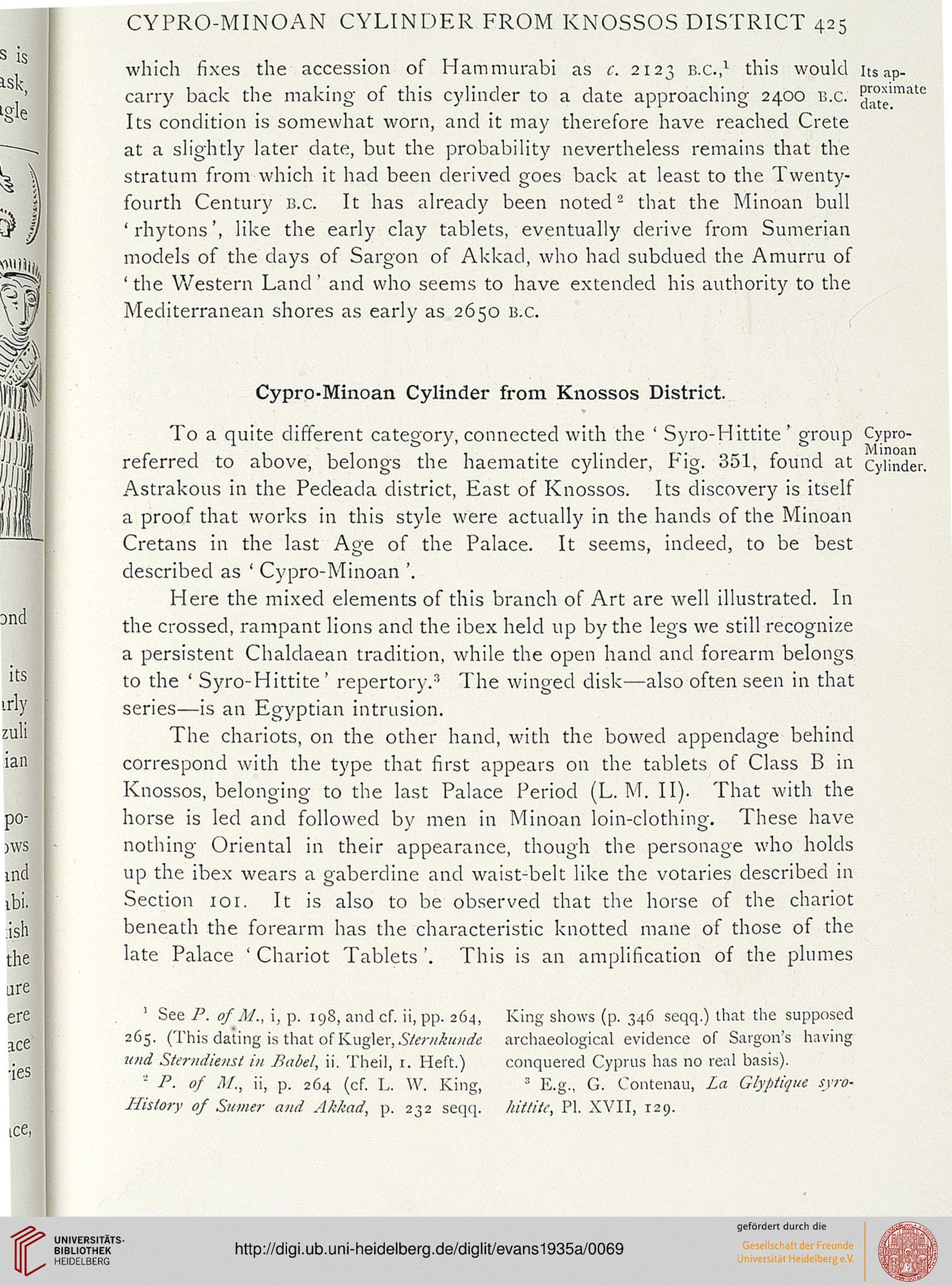CYPRO-MINOAN CYLINDER FROM KNOSSOS DISTRICT 425
which fixes the accession of Hammurabi as c. 2123 B.C.,1 this would Itsap-
carry back the making of this cylinder to a date approaching 2400 B.C. [ja°*lmate
Its condition is somewhat worn, and it may therefore have reached Crete
at a slightly later date, but the probability nevertheless remains that the
stratum from which it had been derived goes back at least to the Twenty-
fourth Century B.C. It has already been noted2 that the Minoan bull
' rhytons', like the early clay tablets, eventually derive from Sumerian
models of the days of Sargon of Akkad, who had subdued the Amurru of
' the Western Land ' and who seems to have extended his authority to the
Mediterranean shores as early as 2650 B.C.
Cypro-Minoan Cylinder from Knossos District.
To a quite different category, connected with the ' Syro-Hittite ' group Cypro-
referred to above, belongs the haematite cylinder, Fig. 351, found at cylinder.
Astrakous in the Pedeada district, East of Knossos. Its discovery is itself
a proof that works in this style were actually in the hands of the Minoan
Cretans in the last Age of the Palace. It seems, indeed, to be best
described as ' Cypro-Minoan '.
Here the mixed elements of this branch of Art are well illustrated. In
the crossed, rampant lions and the ibex held up by the legs we still recognize
a persistent Chaldaean tradition, while the open hand and forearm belongs
to the ' Syro-Hittite' repertory.3 The winged disk—also often seen in that
series—is an Egyptian intrusion.
The chariots, on the other hand, with the bowed appendage behind
correspond with the type that first appears on the tablets of Class B in
Knossos, belonging- to the last Palace Period (L. M. II). That with the
horse is led and followed by men in Minoan loin-clothing. These have
nothing Oriental in their appearance, though the personage who holds
up the ibex wears a gaberdine and waist-belt like the votaries described in
Section 101. It is also to be observed that the horse of the chariot
beneath the forearm has the characteristic knotted mane of those of the
late Palace ' Chariot Tablets'. This is an amplification of the plumes
' See P. of M., i, p. 19S, and cf. ii, pp. 264, King shows (p. 346 seqq.) that the supposed
265. (This dating is that of Kugler, Sternkunde archaeological evidence of Sargon's having
und Sterndienst in Babel, ii. Theil, i. Heft.) conquered Cyprus has no real basis).
5 P. of M., ii, p. 264 (cf. L. W. King, = E.g., G. Contenau, La Glyptique svro-
History of Sinner and Akkad, p. 232 seqq. hitlite, PL XVII, 129.
which fixes the accession of Hammurabi as c. 2123 B.C.,1 this would Itsap-
carry back the making of this cylinder to a date approaching 2400 B.C. [ja°*lmate
Its condition is somewhat worn, and it may therefore have reached Crete
at a slightly later date, but the probability nevertheless remains that the
stratum from which it had been derived goes back at least to the Twenty-
fourth Century B.C. It has already been noted2 that the Minoan bull
' rhytons', like the early clay tablets, eventually derive from Sumerian
models of the days of Sargon of Akkad, who had subdued the Amurru of
' the Western Land ' and who seems to have extended his authority to the
Mediterranean shores as early as 2650 B.C.
Cypro-Minoan Cylinder from Knossos District.
To a quite different category, connected with the ' Syro-Hittite ' group Cypro-
referred to above, belongs the haematite cylinder, Fig. 351, found at cylinder.
Astrakous in the Pedeada district, East of Knossos. Its discovery is itself
a proof that works in this style were actually in the hands of the Minoan
Cretans in the last Age of the Palace. It seems, indeed, to be best
described as ' Cypro-Minoan '.
Here the mixed elements of this branch of Art are well illustrated. In
the crossed, rampant lions and the ibex held up by the legs we still recognize
a persistent Chaldaean tradition, while the open hand and forearm belongs
to the ' Syro-Hittite' repertory.3 The winged disk—also often seen in that
series—is an Egyptian intrusion.
The chariots, on the other hand, with the bowed appendage behind
correspond with the type that first appears on the tablets of Class B in
Knossos, belonging- to the last Palace Period (L. M. II). That with the
horse is led and followed by men in Minoan loin-clothing. These have
nothing Oriental in their appearance, though the personage who holds
up the ibex wears a gaberdine and waist-belt like the votaries described in
Section 101. It is also to be observed that the horse of the chariot
beneath the forearm has the characteristic knotted mane of those of the
late Palace ' Chariot Tablets'. This is an amplification of the plumes
' See P. of M., i, p. 19S, and cf. ii, pp. 264, King shows (p. 346 seqq.) that the supposed
265. (This dating is that of Kugler, Sternkunde archaeological evidence of Sargon's having
und Sterndienst in Babel, ii. Theil, i. Heft.) conquered Cyprus has no real basis).
5 P. of M., ii, p. 264 (cf. L. W. King, = E.g., G. Contenau, La Glyptique svro-
History of Sinner and Akkad, p. 232 seqq. hitlite, PL XVII, 129.





